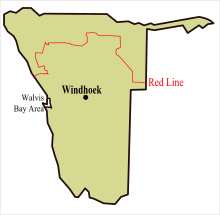Red Line (Namibia)

The Red Line, also referred to as the veterinary cordon fence (VCF) is a pest-exclusion fence separating northern Namibia from the central and southern country parts. It encases several northern regions: Oshana Region, Kavango East Region, Omusati Region, Zambezi Region, Omaheke Region, Kunene Region, and parts of Khomas Region and Oshikoto Region.[1] South of the fence today there commercial farms where the farmers, many of which are white, own the land. Most of these farms are fenced in and are accessible by constructed farm roads. North of the line, on the other hand, all farm land is communal and operated mostly by black farmers. Livestock is not constrained by fences and often ventures onto roads.[2] The red line is a highly guarded line which has roadblocks to check every vehicle which passes.
History
The demarcation was created in 1896 in the hope to contain a Rinderpest outbreak in the Imperial German colony of South-West Africa. Fort Namutoni was built as a Police station to control north-south travel of the indigenous population and their livestock; the line went further to Okaukuejo in the west and Otjituuo in the east. Nevertheless the epidemic reached Windhoek in 1897, wiping out half of the cattle population of the OvaHerero people.[3] Its name stems from the depiction in red ink on a 1911 map created by the German colonial administration.[4] The Red Line was changed several times and was since the 1960s also used to isolate Foot-and-mouth disease outbreaks in the North from the farms in the South.
Removing the Redline
Livestock north of the Red Line line may not be sold overseas, while farmers in the South can sell their meat anywhere. The issues of the red line restrictions have become controversial amidst a 2008 meat market boom.[5] Since the Independence of Namibia in the 1990s, the government has been fighting to remove the Red Line and allow prosperity in these regions. It has been working to build infrastructure, deconcentrate farms and promote the building of farms on virgin lands. Since this line has been deeply embedded in political and historical issues, the government has proposed uprooting it to the Angolan border. This has some concerned that the disease will spread to uninfected areas but areas like Kunene have not had outbreaks in over 30 years and are advocating for this line movement.[5]
References
- ↑ Namibia's Red Line: The History of a Veterinary and Settlement Border, Palgrave MacMillan, 2012, p. 170
- ↑ "Namibia". web.archive.org. Retrieved 24 April 2014.
- ↑ Dierks, Klaus. "Chronology of Namibian History, 1897". klausdierks.com. Retrieved 6 November 2015.
- ↑ "Police Zone". Encyclopedia Britannica online. Retrieved 26 April 2013.
- 1 2 "allAfrica.com: Namibia: VCF Hampers Market Access". web.archive.org. Retrieved 24 April 2014.